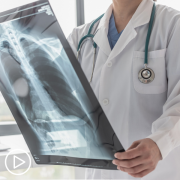Lung Cancer Treatment Decisions: Which Path is Best for You?
Lung Cancer Treatment Decisions: Which Path is Best for You? from Patient Empowerment Network on Vimeo.
Dr. Martin Edelman reviews key factors that help to determine a treatment course for lung cancer patients.
Dr. Martin J. Edelman is Chair of the Department of Hematology/Oncology and Deputy Director for Clinical Research at Fox Chase Cancer Center. More about this expert here.
View more from Fact or Fiction? Lung Cancer
Related Programs:

|

|

Are Clinical Trials Too Risky? A Lung Cancer Expert Reviews the Facts. |
Transcript:
Patricia:
How are you approaching treatment decisions with your patients?
Dr. Edelman:
Well, the treatment decisions that we make – that I make are those that are in ways similar to other medical oncologists. It really depends because some of the patients may first go to a surgeon or whatever. However they come into the system, there are a few key factors in this. First is – make your decision based upon, Number 1, which kind of lung cancer. So, there are two major varieties. You have small cell and non-small cell, and they are treated – they are biologically distinct, and they are treated in distinct ways.
And then the next major consideration is the stage of the tumor, which is our way of expressing how advanced that is and deciding on both the therapy as well as conveying a prognosis and evaluating a patient for a clinical trial. And that’s based upon the size and location of the tumor; presence, absence, and location of lymph nodes; and the presence or absence and, these days, the number of metastatic areas of disease.
And then, lastly, and again depending a little bit upon the stage and interacting with all the others is what condition is the patient in? Anybody can get lung cancer, but still the median is in older individuals.
Many of these patients have compromised cardiac and pulmonary status as well as other diseases of aging, hypertension, cardiac disease, etcetera. Those people – one obviously has to tailor one’s treatments to fit those comorbidities. So, that’s sort of how the basic assessment – obviously, some patients show up with metastatic disease. We know that, but we go through a whole process for this.
The staging system that we use is complicated, and it keeps changing. We’re, gosh, up to version eight of this? I started with version three. I’m not quite sure I’ve fully mastered the current one, and the ninth edition is coming soon. And why does it keep changing? Because our knowledge of the disease keeps changing. The database keeps expanding.
We’re able to be more refined. Molecular variables have not yet fully entered into our considerations. Unquestionably, they will. But basically, one could consider lung cancer – despite the four major stages and multiple substages – that you really have three buckets that people will fit into. They have localized disease, which we will predominantly address with a localized therapy – surgery, radiation. And many of those patients, however, particularly those who might have a lymph node that’s positive, will benefit from chemotherapy to prevent recurrence.
We have patients with locally advanced disease. Primarily, those are patients who have lymph nodes located in the middle of the chest as opposed to more localized disease where if there’s a lymph node present it’s more in the lobe of the lung. Those patients with lymph nodes in the middle of the chest or larger tumors are approached with frequently a combination of chemotherapy, radiation, sometimes surgery.
And then we have patients with advanced disease who will be predominantly treated with drug therapies, which nowadays, depending upon the molecular background of the tumor, could be a targeted treatment if they have a specific mutation.
Something we see most frequently, though certainly not exclusively, in patients with scant or no smoking history, they may be approached with immunotherapy or chemotherapy combined with immunotherapy.
And there are many considerations that go into those decisions. And even in advanced stage, there are certainly roles for surgery and radiation depending upon whether there are structural abnormalities, occasionally whether there are relatively few areas or several areas of metastatic disease. And in the localized and locally advanced disease, our goal is cure in those, though we certainly are not there for every patient yet.
And in advanced disease, it’s extension of life, which is now quite considerable compared to untreated disease. And I think in certain situations, particularly those who only have a single area of metastatic disease, curative treatment is a realistic possibility. And even those with more disseminated disease, we’re now beginning to see a substantial fraction of patients who are still alive at five years or more. So, we’re beginning very cautiously to think that perhaps some of those patients may even be cured of their disease, though I’m not quite ready to say that.







![[ACT]IVATED Program Logo [ACT]IVATED Program Logo](https://powerfulpatients.org/wp-content/uploads/Program-page-image-option-1-180x180.png)


